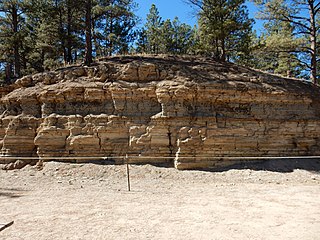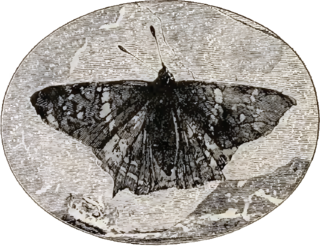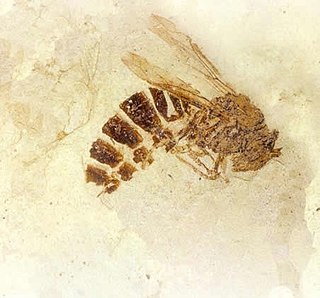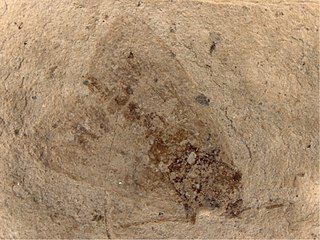
The Florissant Formation is a sedimentary geologic formation outcropping around Florissant, Teller County, Colorado. The formation is noted for the abundant and exceptionally preserved insect and plant fossils that are found in the mudstones and shales. Based on argon radiometric dating, the formation is Eocene in age and has been interpreted as a lake environment. The fossils have been preserved because of the interaction of the volcanic ash from the nearby Thirtynine Mile volcanic field with diatoms in the lake, causing a diatom bloom. As the diatoms fell to the bottom of the lake, any plants or animals that had recently died were preserved by the diatom falls. Fine layers of clays and muds interspersed with layers of ash form "paper shales" holding beautifully-preserved fossils. The Florissant Fossil Beds National Monument is a national monument established to preserve and study the geology and history of the area.

Florissantia is an extinct genus of flowering plants in the Malvaceae subfamily Sterculioideae known from western North America and far eastern Asia. Flower, fruit, and pollen compression fossils have been found in formations ranging from the Early Eocene through to the Early Oligocene periods. The type species is Florissantia speirii and three additional species are known, Florissantia ashwillii, Florissantia quilchenensis, and Florissantia sikhote-alinensis.

Florissantoraphidia is an extinct genus of snakefly in the family Raphidiidae containing two described species Florissantoraphidia funerata and Florissantoraphidia mortua. Both species were originally placed in the living raphidiid genus Raphidia, as Raphidia funerata and Raphidia mortua respectively. before being redescribed and transferred to the newly erected genus in 2014.

Prodryas persephone is an extinct species of brush-footed butterfly, known from a single specimen from the Chadronian-aged Florissant Shale Lagerstätte of Late Eocene Colorado. P. persephone is the first fossil butterfly to be found in North America, and is exquisitely well preserved. Its closest extant relatives are the mapwings and African admirals of the genera Hypanartia and Antanartia, respectively.

Palaeovespa is an extinct genus of wasp in the Vespidae subfamily Vespinae. The genus currently contains eight species: five from the Priabonian stage Florissant Formation in Colorado, United States, two from the middle Eocene Baltic amber deposits of Europe, and one species from the late Paleocene of France.
Anthidium scudderi is an extinct species of mason bee in the Megachilidae genus Anthidium. The species is solely known from the late Eocene, Chadronian stage, Florissant Formation deposits in Florissant, Colorado, USA. Anthidium scudderi is one of only four extinct species of mason bees known from the fossil record, and with Anthidium exhumatum, one of two species from the Florissant Formation.
Anthidium exhumatum is an extinct species of mason bee in the Megachilidae genus Anthidium. The species is solely known from the late Eocene, Chadronian stage, Florissant Formation deposits in Florissant, Colorado, USA. Anthidium exhumatum is one of only four extinct species of mason bees known from the fossil record, and with Anthidium scudderi, one of two species from the Florissant Formation.

The Lepidoptera fossil record encompasses all butterflies and moths that lived before recorded history. The fossil record for Lepidoptera is lacking in comparison to other winged species, and tending not to be as common as some other insects in the habitats that are most conducive to fossilization, such as lakes and ponds, and their juvenile stage has only the head capsule as a hard part that might be preserved. Yet there are fossils, some preserved in amber and some in very fine sediments. Leaf mines are also seen in fossil leaves, although the interpretation of them is tricky. Putative fossil stem group representatives of Amphiesmenoptera are known from the Triassic.

Paleolepidopterites is a collective genus of fossil moths which can not be placed in any defined family. The included species were formerly placed in the leaf-roller family Tortricidae and are known from fossils found in Russia and the United States. The collective genus contains three species: Paleolepidopterites destructus, Paleolepidopterites florissantanus, and Paleolepidopterites sadilenkoi, formerly placed within the genera Tortrix and Tortricites respectively. The three species were formally redescribed and moved to the new collective genus by Heikkilä et al. (2018).

Hydriomena? protrita is an extinct species of moth in the family Geometridae, and possibly in the modern genus Hydriomena. The species is known from late Eocene, Priabonian stage, lake deposits of the Florissant Formation in Teller County, Colorado, United States. It was first described by Theodore Dru Alison Cockerell in 1922.

Eulithomyrmex is an extinct genus of ant in the formicid subfamily Agroecomyrmecinae. The genus contains two described species, Eulithomyrmex rugosus and Eulithomyrmex striatus. Eulithomyrmex is known from a group of Late Eocene fossils which were found in North America.
Aphaenogaster donisthorpei is an extinct species of ant in formicid subfamily Myrmicinae known from a Late Eocene fossil from North America. A. donisthorpei was one of two Aphaenogaster species described in the 1930 paper.

The White River Formation is a geologic formation of the Paleogene Period, in the northern Great Plains and central Rocky Mountains, within the United States.

Aphaenogaster mayri is an extinct species of ant in formicid subfamily Myrmicinae known from a series of Late Eocene fossils found in North America. A. mayri was one of two Aphaenogaster species described in a 1930 paper by Frank M. Carpenter.

Archiponera is an extinct genus of ant in the formicid subfamily Ponerinae. The genus contains a single described species, Archiponera wheeleri known from several Late Eocene fossils which were found in North America.
Priabona is an extinct genus of big-headed flies in the dipteran subfamily Nephrocerinae, within which it is one of only two genera. The genus contains a single described species, Priabona florissantius. Priabona is known from a single Late Eocene fossil from western North America.

Holcorpa is a genus of extinct insects in the scorpionfly order Mecoptera. Two Eocene age species found in Western North America were placed into the genus, H. dillhoffi and H. maculosa.

Florissantia is an extinct monotypic genus of planthopper in the dictyopharid subfamily Dictyopharinae. The single species, Florissantia elegans, was described by Samuel Hubbard Scudder (1890) from fossils found in the Florissant Formation of Colorado.

Dipteronia brownii is an extinct species in the soapberry family (Sapindaceae) described in 2001. Fossils of D. brownii are known from stratigraphic formations in North America and Asia ranging in age between Paleocene to Early Oligocene.

Polystoechotites is an extinct parataxon of lacewings in the moth lacewing family Ithonidae. The taxon is a collective group for fossil polystechotid giant lacewing species whose genus affiliation is uncertain, but which are distinct enough to identify as segregate species. Polystoechotites species are known from Eocene fossils found in North America and is composed of four named species Polystoechotites barksdalae, Polystoechotites falcatus, Polystoechotites lewisi, and Polystoechotites piperatus, plus two unnamed species. Three of the described species are known from fossils recovered from the Eocene Okanagan Highlands of Washington State, while the fourth is from Colorado.














